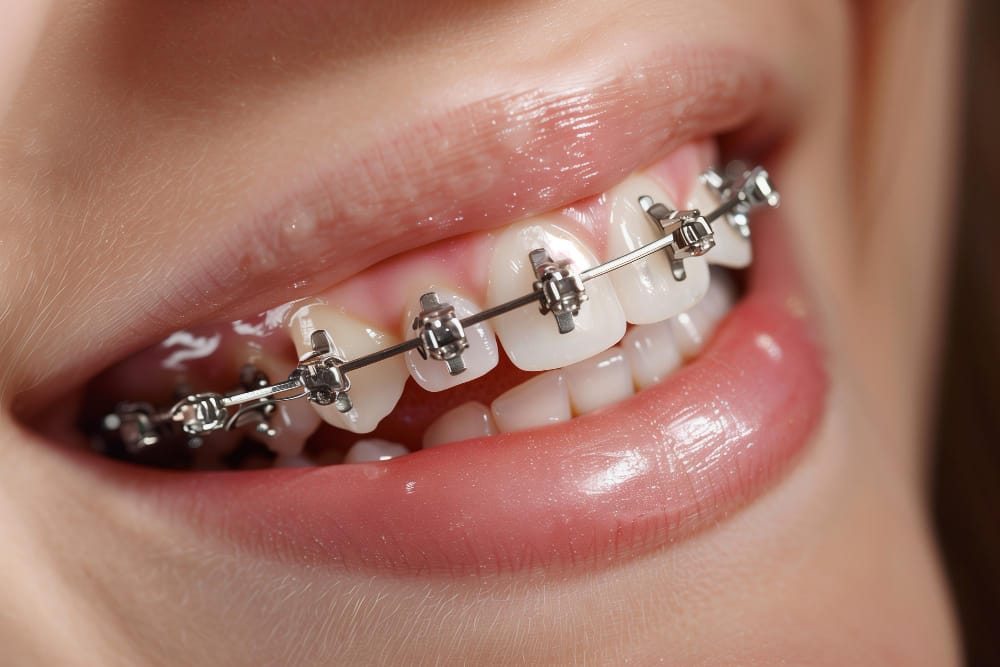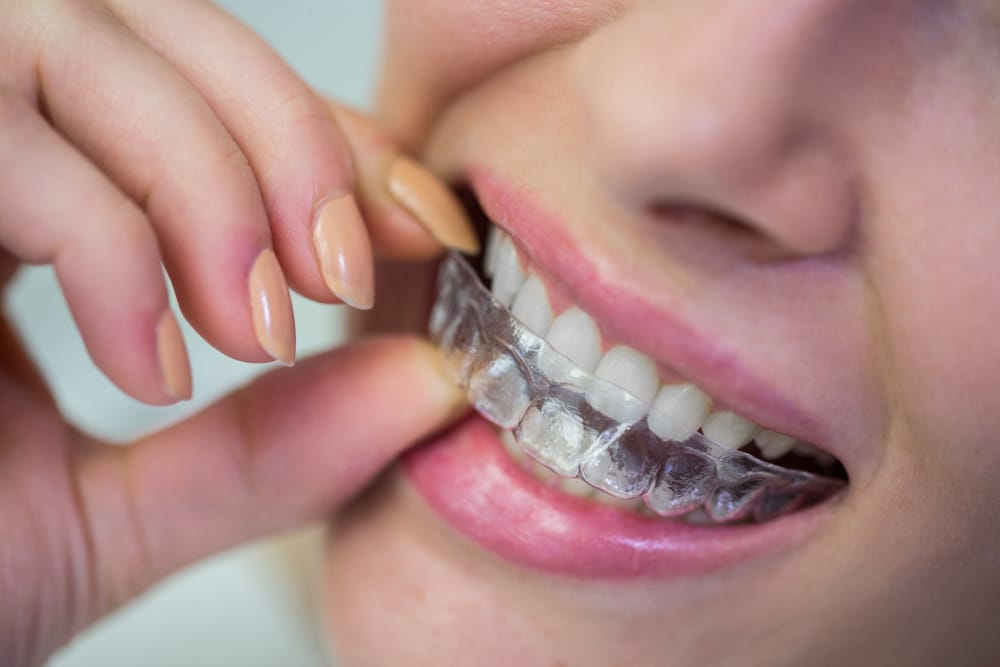Aligners vs Braces: Which Is Best for Your Perfect Smile?
If you’re considering straightening your teeth, these are the two most popular orthodontic treatments in India. Traditional braces have been trusted for decades, but clear aligners are gaining popularity among teenagers and professionals who want a modern, nearly invisible option.
In this guide, we’ll compare braces and aligners side by side, covering costs, comfort, treatment duration, and effectiveness so you can decide which is right for your smile.
Overview: Aligners vs Braces - What's The Difference?
Aligners and braces both straighten teeth but differ in design and comfort. Aligners are clear, removable trays that offer a more discreet and convenient option, ideal for mild to moderate alignment issues. Braces, on the other hand, use fixed brackets and wires, making them more effective for complex cases. Aligners provide easier cleaning and better aesthetics but require consistent wear, while braces are typically more affordable and deliver precise results for severe misalignments. The right choice depends on your dental needs, budget, and lifestyle preferences.
Now lets dive deep and explore each of them.
What are Braces?

Braces are orthodontic devices made up of brackets, wires, and bands that apply continuous pressure on the teeth to gradually move them into alignment. They remain fixed throughout the treatment, meaning you can’t remove them once fitted.
How Do Traditional Braces Work?
Traditional braces work by applying controlled force on your teeth using brackets bonded to the tooth surface and connected with wires. These wires are periodically tightened by an orthodontist, guiding teeth into their desired position.
Over time, braces correct issues like crowding, spacing, overbites, and severe misalignments. Because of their effectiveness in complex cases, braces are still considered the gold standard by many orthodontists.
Types of Braces
Braces come in different forms to suit varying needs and preferences. The most common types of braces include:
- Traditional Metal Braces: Stainless steel bands, brackets, and wires. Highly visible but equally effective.
- Ceramic Braces: Tooth-coloured brackets and wires that blend better but are more fragile.
- Lingual Braces: Placed behind the teeth, making them almost invisible but trickier to clean.
- Self-Ligating Braces: Similar to metal braces but use clips instead of elastic bands, reducing friction and treatment time.
What are Aligners?

Clear aligners are transparent, removable trays custom-made to fit snugly over your teeth. They gradually shift your teeth into alignment without the need for metal brackets or wires.
How Do Clear Aligners Work?
Also known as invisible braces, aligners work in stages. Each set of trays is worn for about 1 to 2 weeks before switching to the next one in the series, with each tray moving your teeth slightly closer to the final position.
Unlike traditional braces, aligners are removable, which means you can eat, brush, and floss without restrictions.
Braces vs Aligners: Key Differences
Braces have fixed metal wires and brackets that apply pressure on the teeth to straighten them. Due to this constant pressure, they are widely used to treat complex issues like crowding, overbites, and other alignment problems. But these are visible and challenging to clean. On the other hand, aligners are clear, removable, and more convenient to use, but they cannot address major alignment issues.
Both of these teeth straightening methods come with their own sets of pros and cons. Hence, we are here to give you a detailed difference between braces and aligners across different factors:
Factor | Clear Aligners | Braces |
|---|---|---|
Appearance | Clear, nearly invisible | Noticeable, but the ceramic ones are comparatively less noticeable |
Comfort | Smooth, minimal irritation | May cause soreness & irritation in the gums from the wires |
Diet | No restrictions since they are removable | You have to avoid hard, chewy, and sticky food |
Cleaning | Easy, as you can easily remove them to brush and floss your teeth | Require special attention when brushing |
Compliance | Needs 22 hrs/day wear | Since these are non-removable, there are no compliance issues |
Effectiveness | Works for mild to moderate cases | Works for all cases, even complex ones |
Duration | 6 to 18 months, with regular change in trays | Around 2 to 3 years |
Appointments | Fewer, shorter visits | Frequent, longer adjustment sessions |
Cost | Usually higher | Lower upfront |
- Appearance: Aligners are discreet and barely noticeable, making them ideal for those conscious about their looks. Braces, even ceramic ones, are still more visible.
- Comfort: Aligners are smooth and custom-fitted, reducing mouth irritation. Braces can poke or cause soreness after adjustments.
- Dietary Restrictions: Aligners can be removed before meals, so you can enjoy all your favourite foods, from crunchy samosas to chewy sweets. With braces, sticky or hard foods are best avoided.
- Hygiene & Cleaning: Aligners make oral care easy since you can brush and floss normally. Braces, however, require extra tools like interdental brushes or water flossers.
- Compliance & Removability: Braces work 24/7 without any effort from you, apart from you having to take care of your diet. Clear aligners, on the other hand, demand discipline. You must wear them for at least 22 hours daily for the best results.
- Effectiveness & Applicability: Braces treat everything from minor gaps to severe bite issues. Aligners are highly effective for mild to moderate misalignments but may not suit very complex cases.
- Treatment Duration: Aligners can sometimes work faster (6 to 18 months) if there’s mild misalignment, while braces usually take 2 years or more. But this depends on the severity of your case.
- Appointments: Aligners involve fewer clinic visits since multiple trays can be given in advance. Braces require regular tightening.
- Cost Considerations: Braces usually cost less upfront, while aligners may have a higher price tag but save you time with fewer visits.
Cost Considerations: Clear Aligners vs. Traditional Braces
While clear aligners come with a higher price tag, it’s usually a one-time upfront cost that can offer long-term savings through fewer dental appointments. On the other hand, traditional braces may appear cheaper at first, but they require frequent visits and additional expenses for tightening, adjustments, and other complications.
Initial Cost Comparison
- Invisible Aligners: ₹35,000 – ₹1,50,000 (depending on brand and complexity).
- Metal Braces: ₹25,000 – ₹70,000.
- Ceramic Braces: ₹40,000 – ₹1,00,000.
Factors Influencing Cost
- Brand: Different aligner brands, like Invisalign® or ClearCorrect®, have their own pricing.
- Complexity: More complex cases require more trays, increasing costs.
- Location & Orthodontist Fees: Clinics in metros often charge more.
- Material: Metal braces are cheaper than ceramic.
Other Potential Costs
- Aligners: Lost trays may cost ₹3,000 to ₹10,000 per set. Follow-ups cost around ₹500 to ₹2,000.
- Braces: Regular adjustments cost ₹1,000 to ₹3,000. Retainers and accessories cost ₹1,000 to ₹5,000.
Overall Cost Perspective
While braces are cheaper upfront, aligners save time and travel with fewer visits. For busy professionals, students, and those worried about their appearance, aligners can be a worthwhile investment in convenience.
Braces vs Aligners: How to Choose the Right Option
When deciding between braces and aligners, think about your dental condition, lifestyle, and how important appearance is to you. Braces are usually the go-to for more complex issues and tend to be lighter on the pocket. On the other hand, clear aligners are discreet, comfortable, and flexible, but they do require discipline since you’ll need to wear them for most of the day.
The smartest step? Book a consultation with Dezy to understand which option will truly work best for your smile! We’ll analyse your requirements and lifestyle to provide you with the best treatment option.
Braces or Aligners? Let Dezy Help You Decide!
Book Your Free Consultation Today!To get a clear idea before the consultation, here are some factors to consider:
- Complexity: Severe misalignments may need braces.
- Visibility: If discreet treatment is key, aligners win.
- Commitment: Aligners need discipline to wear daily.
- Budget: Consider initial and ongoing costs.
- Lifestyle: Diet, social events, and sports may influence your choice.
When to Choose Braces:
- Severe crowding, bite issues, or rotations.
- If daily compliance is a concern.
- When upfront cost is a priority.
When to Choose Aligners:
- Mild to moderate misalignment.
- Preference for aesthetics and comfort.
- Need flexibility for food, travel, or special events.
Conclusion
Both braces and aligners are proven and effective ways to achieve a straighter, healthier smile. Braces remain the gold standard for correcting complex issues and are usually more budget-friendly upfront. Clear aligners, on the other hand, provide comfort, flexibility, and a nearly invisible look, making them ideal for those who value aesthetics and convenience.
Ultimately, the best choice depends on your dental condition, lifestyle, and budget. The smartest step is to consult with an orthodontist who can assess your needs and recommend the treatment that will deliver the best results for your smile.
Braces or Aligners? Let Dezy Help You Find Your Perfect Smile.
Book Your Free Consultation Today!FAQs
1. Are braces still the best option for teeth straightening in India?
Yes, braces remain highly effective, especially for complex cases. They also come with a lesser upfront cost as compared to aligners, making it a good option for families on a budget.
2. Are invisible aligners effective for crooked teeth?
Yes, clear aligners can correct mild to moderate crooked teeth. For severe cases, braces may still be recommended.
3. Which is better for complex cases: braces or aligners?
Braces are usually better for complex crowding, bite problems, or rotations. Aligners are better for simpler cases needing discretion and comfort.
4. Which is better, aligners or braces?
Neither is “better” universally. Aligners offer comfort and invisibility, while braces handle tough cases. The right choice depends on your needs, lifestyle, and budget.
5. Are aligners faster than braces?
In many mild-to-moderate cases, aligners work faster (6 to 18 months). Braces typically take 2 to 3 years.
6. Can I eat normally with braces or aligners?
It’s easier to eat normally with aligners, as you simply remove them before meals. Braces, however, restrict certain foods like sticky sweets or crunchy snacks.
7. Are aligners as painful as braces?
Both can cause mild discomfort as teeth shift. Aligners are generally smoother and less irritating than braces.

